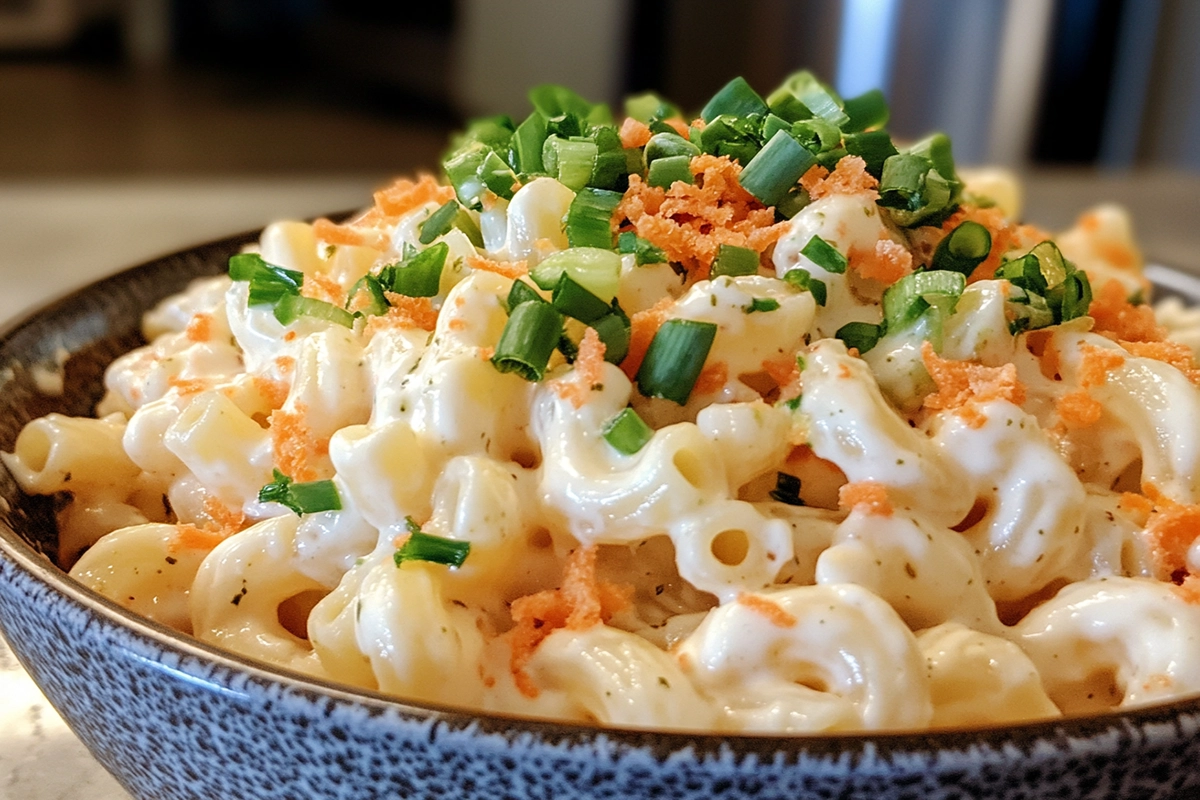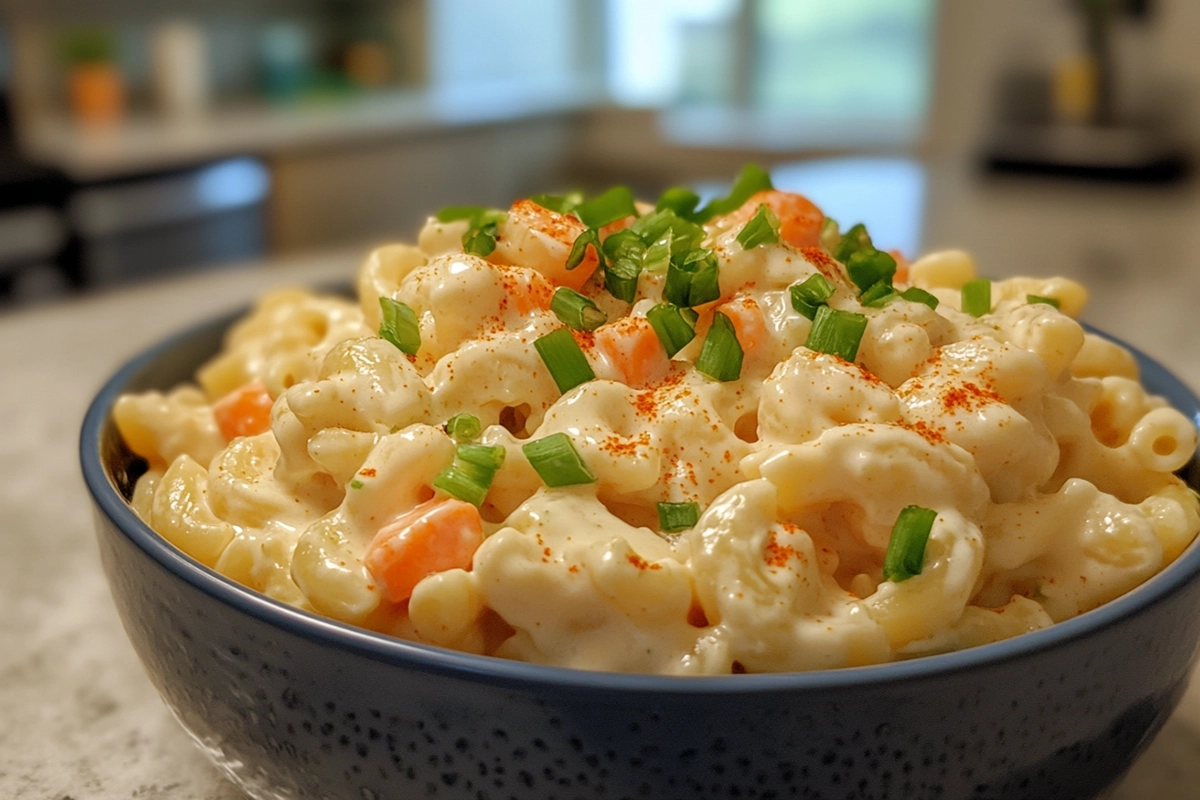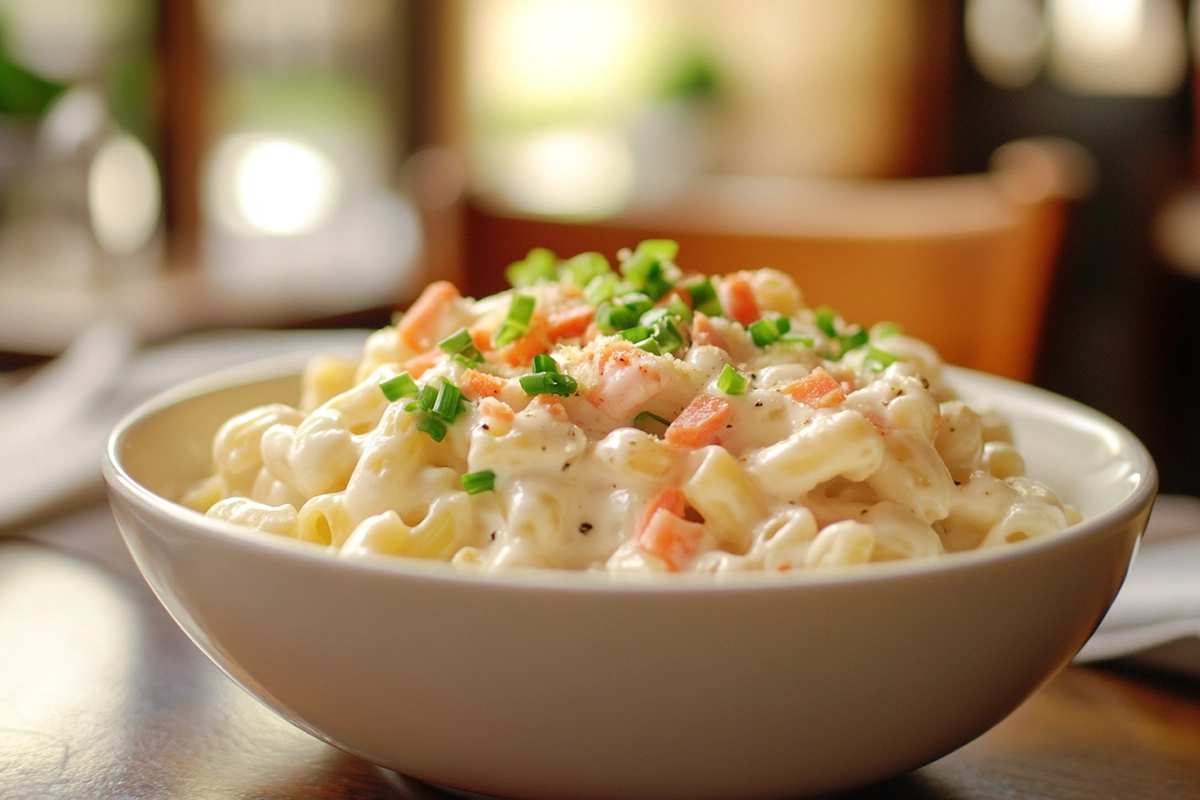Hawaiian mac salad is a beloved side dish that stands out for its creamy texture, subtle tang, and unique flavor, often found alongside plate lunches. While it might look similar to the traditional American macaroni salad, its taste and preparation differ significantly. This article explores the history, key ingredients, traditional preparation techniques, and variations that make Hawaiian mac salad distinct. For those interested in another salad option, try this refreshing broccoli crunch salad recipe, which offers a different yet delightful combination of flavors.
Table of Contents
The History and Cultural Influence of Hawaiian Mac Salad
Hawaiian mac salad has a fascinating origin that reflects Hawaii’s multicultural history. The dish became popular as part of the plate lunch, a meal that typically includes rice, a protein, and mac salad. The plate lunch is influenced by the cuisines of immigrants from Japan, China, Portugal, and the Philippines, who came to work in Hawaii’s sugar and pineapple plantations. They brought with them their culinary traditions, which merged with American-style cooking to create a new hybrid cuisine.
By the 20th century, mac salad had solidified its place in local Hawaiian food culture. Its simple ingredients made it accessible and affordable, while its creamy consistency balanced the flavors of the other components in the plate lunch. The dish evolved over the years, gaining a reputation as a comfort food enjoyed by locals and tourists alike.
Key Ingredients That Contribute to the Distinct Flavor
Several ingredients contribute to the distinctive taste of Hawaiian mac salad. While most recipes follow a simple formula, certain details in ingredient choice set it apart from other versions of macaroni salad.
- Full-Fat Mayonnaise
Hawaiian mac salad typically uses full-fat mayonnaise, which adds to its richness. The fat content in the mayonnaise gives the salad a creamy texture and mouthfeel. Unlike lighter or low-fat versions, full-fat mayonnaise ensures that the flavors meld together seamlessly. - Apple Cider or Rice Vinegar
A hint of acidity from apple cider vinegar or rice vinegar provides balance to the creamy texture. This subtle tang is one of the distinguishing features of Hawaiian mac salad, as it cuts through the richness and adds depth to the dish. - Grated Onion and Other Vegetables
Grated onion often makes its way into Hawaiian mac salad, offering a slight sharpness that complements the creaminess. Sometimes, finely grated carrots are also included for a touch of sweetness, enhancing the overall flavor. - Overcooked Macaroni
One aspect that surprises many is the preference for slightly overcooked macaroni. This method allows the pasta to absorb more of the mayonnaise and seasoning, resulting in a cohesive texture where the noodles are soft and fully coated. While traditional pasta dishes aim for al dente, Hawaiian mac salad embraces a softer texture.
Traditional Preparation Techniques
Preparing authentic Hawaiian mac salad requires specific techniques to achieve the right consistency and flavor. While it may seem like a straightforward dish, attention to detail makes a difference in the final result.
Cooking the Macaroni Beyond Al Dente
Unlike most pasta dishes, Hawaiian mac salad calls for cooking the macaroni until it’s very tender. This helps the noodles soak up the dressing, creating a creamier texture. The extra moisture absorbed by the overcooked pasta ensures that the salad doesn’t dry out when chilled.
Chilling the Salad Before Serving
Allowing the salad to chill in the fridge for a few hours, or even overnight, helps the flavors meld together. This step is crucial because it allows the pasta to continue absorbing the dressing, resulting in a more flavorful dish.
Mixing Ingredients Thoroughly
Proper mixing ensures that every bite of the salad is consistent. The mayonnaise, vinegar, and grated vegetables should coat the pasta evenly without overwhelming any single element.

Common Variations of Hawaiian Mac Salad
While the traditional recipe is simple, there are regional variations and adaptations that introduce new flavors to Hawaiian mac salad. These additions may change the flavor profile but still maintain the core aspects of the dish.
Adding Proteins Like Tuna or Imitation Crab
In some variations, proteins such as tuna or imitation crab are mixed into the salad, making it heartier. This variation is popular at local delis and adds a touch of umami to the dish.
Incorporating Sweeteners
Some recipes include a hint of sugar or pineapple juice for extra sweetness. The added sweetness balances the acidity from the vinegar and the creaminess of the mayonnaise, making the salad more appealing to those who prefer a milder flavor.
Asian-Inspired Additions
Incorporating ingredients like soy sauce, sesame oil, or furikake (a Japanese seasoning) adds an umami-rich dimension. These Asian-inspired elements reflect the multicultural influence on Hawaiian cuisine and create a new twist on the traditional dish.

The Importance of Plate Lunch in Hawaiian Culture
The plate lunch has been a significant part of Hawaiian food culture since the early 20th century. A typical plate lunch consists of a protein such as teriyaki chicken, kalua pork, or beef, served alongside a generous helping of white rice and a scoop of mac salad. The mac salad acts as a creamy, tangy contrast to the savory protein and neutral rice. Over time, the mac salad has evolved to become a cultural staple, representing the blending of different culinary traditions. You can read more about the history of Hawaiian plate lunch to understand how these culinary influences came together.
Nutritional Considerations for Hawaiian Mac Salad
While Hawaiian mac salad is delicious, it’s not necessarily the healthiest option due to its high-fat content from the mayonnaise. However, there are ways to make it lighter without compromising the taste:
- Substitute Full-Fat Mayo with Greek Yogurt or Low-Fat Mayo
Using Greek yogurt or low-fat mayonnaise can reduce the calorie count while still maintaining a creamy texture. - Add More Vegetables for Fiber
Incorporating more grated carrots, celery, or even bell peppers can increase the fiber content and add a crunch to the salad. - Limit the Portion Size
As with many indulgent foods, enjoying Hawaiian mac salad in moderation can help balance your overall diet.
FAQs About Hawaiian Mac Salad
1. Why is the macaroni overcooked in Hawaiian mac salad?
Cooking the macaroni beyond al dente ensures that it absorbs more of the dressing, making the salad creamier. The softer noodles soak up the mayonnaise and seasonings, resulting in a consistent flavor throughout. This method also prevents the salad from becoming dry, as the extra moisture in the pasta helps retain its creamy texture.
2. Can you make a healthier version of Hawaiian mac salad?
Yes, you can make a lighter version by using low-fat mayonnaise or Greek yogurt as a substitute. Adding more vegetables like grated carrots or chopped celery also boosts the nutritional value while retaining the traditional taste. You can also reduce the portion of mayonnaise and increase the vinegar for a slightly tangier, lower-calorie version.
3. What is the difference between Hawaiian mac salad and traditional mac salad?
The primary differences lie in the texture and flavor. Hawaiian mac salad often uses overcooked pasta to absorb more dressing, giving it a softer texture. It also includes a hint of vinegar, which adds a subtle tang that is not common in mainland versions. The choice of vegetables, such as grated carrots and onions, also adds to the distinctiveness.
4. Why is vinegar used in Hawaiian mac salad?
The vinegar adds a bit of acidity that helps balance the richness of the mayonnaise. It also adds a slight tang to the flavor, which makes the salad more refreshing. In addition, the vinegar acts as a preservative, helping to extend the shelf life of the salad when stored in the refrigerator.
5. How long can you store Hawaiian mac salad?
Properly stored in an airtight container, Hawaiian mac salad can last up to three days in the refrigerator. To maintain its quality, avoid leaving it out at room temperature for extended periods. If you have leftovers, make sure to refrigerate them as soon as possible to prevent spoilage and preserve the creamy texture.
Culinary Tips for Perfecting Hawaiian Mac Salad
To make the best Hawaiian mac salad at home, follow these tips:
- Choose Full-Fat Mayonnaise for Authentic Flavor
The full-fat version provides the richness that characterizes traditional mac salad. Using lower-fat options may result in a less creamy texture. - Let the Salad Rest Overnight
Allowing the salad to rest in the fridge overnight ensures that the flavors meld together perfectly. - Experiment with Add-ins
While sticking to the traditional recipe is delicious, adding personal touches like chopped scallions, peas, or even bits of bacon (for a non-traditional variation) can elevate the dish. The key is to experiment with flavors that complement the tangy and creamy profile of the original recipe.
Conclusion
Hawaiian mac salad stands out because of its special taste, which mixes the creamy feel of mayonnaise, the tangy kick of vinegar, and the softness of well-cooked pasta. Its history as part of the plate lunch has made it a symbol of Hawaii’s culture. While you can make different versions, learning about the traditional ways to prepare it and the main ingredients helps you appreciate what sets it apart.
Whether you’re making the dish at home or enjoying it at a local Hawaiian eatery, Hawaiian mac salad gives a taste of Hawaii’s rich food traditions. For more on the cultural influences in Hawaiian cooking, check out Hawaiian Cuisine to see how different flavors and styles came together to shape this popular dish.
Now that you know the secrets behind its unique taste, you can create your own Hawaiian mac salad at home or enjoy it with your next plate lunch.

